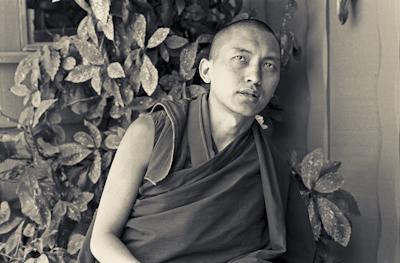By practicing mindfulness of emptiness in our daily life, as I mentioned before, when our mind is totally aware there’s no I on these aggregates, then whether somebody praises us or puts us down, it doesn’t affect us, it doesn’t bring our life up or down. There’s continual inner peace, happiness and tranquility. We don’t suffer due to the external conditions, we don’t create negative karma by delusions arising and we don’t create the cause of suffering.
Also I mentioned practicing mindfulness, so even if we’re thinking of the I, if we see that the I is merely imputed by the mind, when we’ve discovered that, or when we are in mindful meditation of that, then receiving material things or not, receiving presents or not, like birthday presents, or receiving praise, criticism or a bad reputation—none of these things bother us. They don’t make us suffer, so then we can overcome that. We don’t create negative karma, we don’t get angry or get attached to things, and so we don’t create the cause of samsara.
Whatever activity we are doing in our daily life, practice mindfulness of the merely labeled I, the merely labeled action and the merely labeled object. Practice mindfulness of this, how everything is merely labeled by mind. So whatever activity we are doing, practice mindfulness of this, then during that time the delusions—anger, attachment, ignorance—do not arise. Then that brings us to liberation and it becomes the antidote to samsara. So, whatever we’re doing becomes the antidote to samsara. It eliminates ignorance, the root of suffering, so like that, we recognize the hallucination as a hallucination. This real I is not there; it is a hallucination which is not there.
Just as this truly existent I is not there, it is a hallucination, it is false, whatever action we’re doing, this real action, this truly existent action, is false. For example, if we’re walking—real walking as a truly existent action—that is totally false. The real I or the real walking is totally false. In the same way, the real I looking at it is false, and the real action of walking is a hallucination, it’s false.
And then the road we’re walking on, the real road is not there. If we look, if we search for where the real road is, we can’t find it. It’s exactly the same. Just as we can’t find the I on these aggregates, we can’t find the real road if we look for it. When we don’t examine the road, it looks as if there’s a real road there, but if we look for it, it’s not there. So, we can look at the real road as false, as a hallucination. We can look at the hallucination as a hallucination. So, whatever activity we are doing, we can look at it as a hallucination or like a dream.
A dream is a very good example. A dream is an excellent example. The I is a dream, the action is a dream, and the object is a dream. We can look at everything as a dream, as a continuation of last night’s dream. Looking at everything as a dream is very effective; it’s a very good meditation.
In a dream, whatever we’re doing—walking, sitting or eating food—is all labeled by our mind. It’s all labeled by our mind, but it’s not there, it doesn’t exist at all. We can dream of winning a billion dollars in a lottery, so we go there, we get a billion dollars, we put it in our bag and the bag becomes very heavy. But when we wake up, it’s not there. It’s like that. All this—the real I, the real action, the real road, the real eating, the real food—everything is false. So, we can look at it like a dream.
Seeing everything as a dream is another good meditation. Whatever we’re doing—I, action, object—whatever appears as not merely labeled by the mind or existing from its own side, we can look at it all as a dream. Keeping mindfulness like this as much as possible is very powerful, very effective. That’s a very good meditation; it’s very powerful. I’m not going to use other quotations.
Another meditation technique on emptiness is seeing our ignorance as a magician. The magician uses mantra or some substances or whatever, to hallucinate the audience’s senses. Then the ignorance leaves a negative imprint on the mind.
Like a magician, our ignorance projects the hallucination of true existence onto everything that is merely labeled by our mind—the I, the action, the object, hell, enlightenment, samsara and nirvana. It projects the hallucination of true existence on the merely labeled I, the merely labeled action, the merely labeled object, the merely labeled hell, the merely labeled enlightenment, the merely labeled samsara, the merely labeled nirvana, the merely labeled happiness, the merely labeled problem. This ignorance creates illusions for us completely in our life. It decorates this hallucination of true existence on every merely labeled thing—the merely labeled I, the merely labeled action, the merely labeled object. It totally creates illusions for us; it completely creates illusions for us.
This ignorance is like the magician and we are like the audience. The magician creates illusions for the senses of the audience so they see all things totally wrongly. Nothing is true. Ignorance totally creates illusions for us like a magician, it totally creates illusions for our whole life. So that’s another practice of mindfulness in our busy lives. That’s how to meditate on emptiness in our daily lives, in our busy lives. Part of our mind should always be in this meditation, whether we’re talking, driving a car or shopping.
The heart of Buddhism is the three principal aspects of the path to enlightenment, so emptiness, the right view, is a very important practice.





























